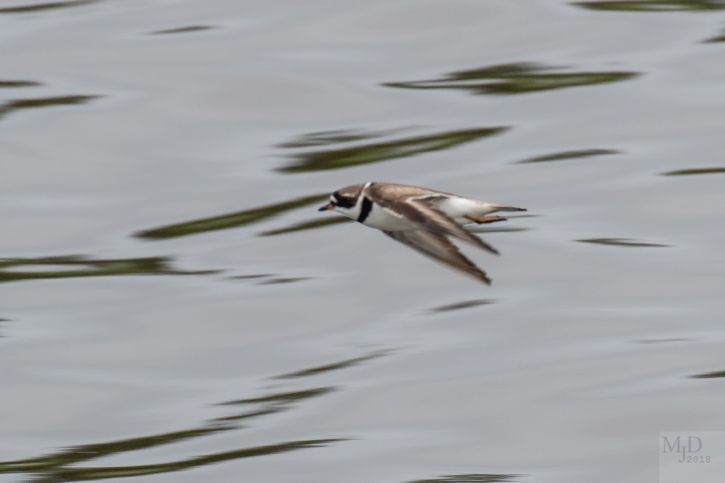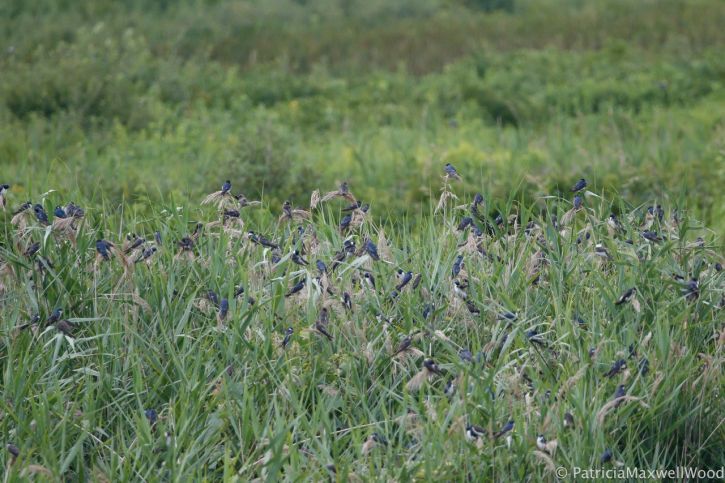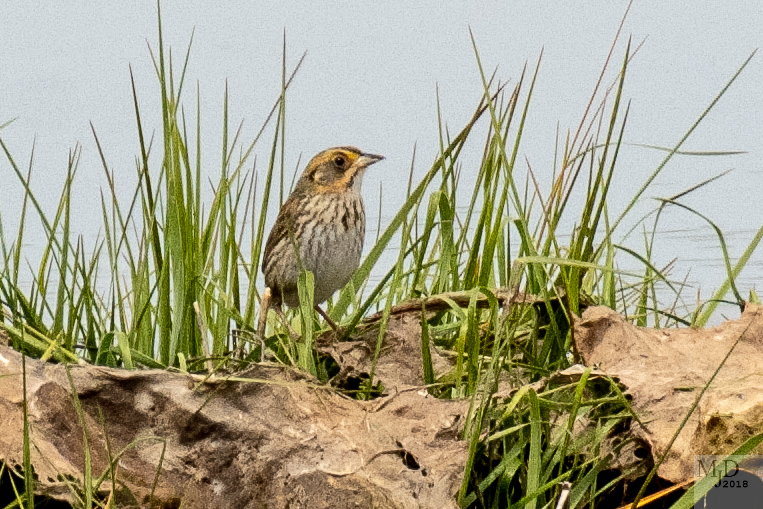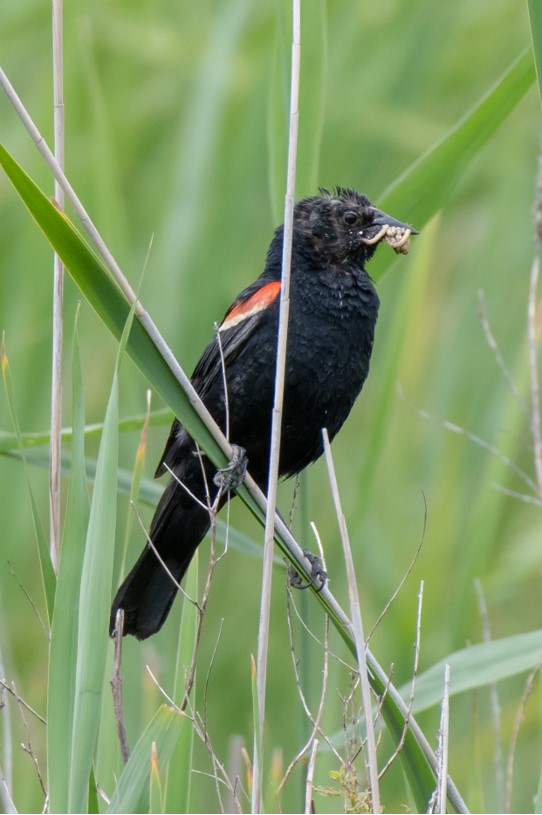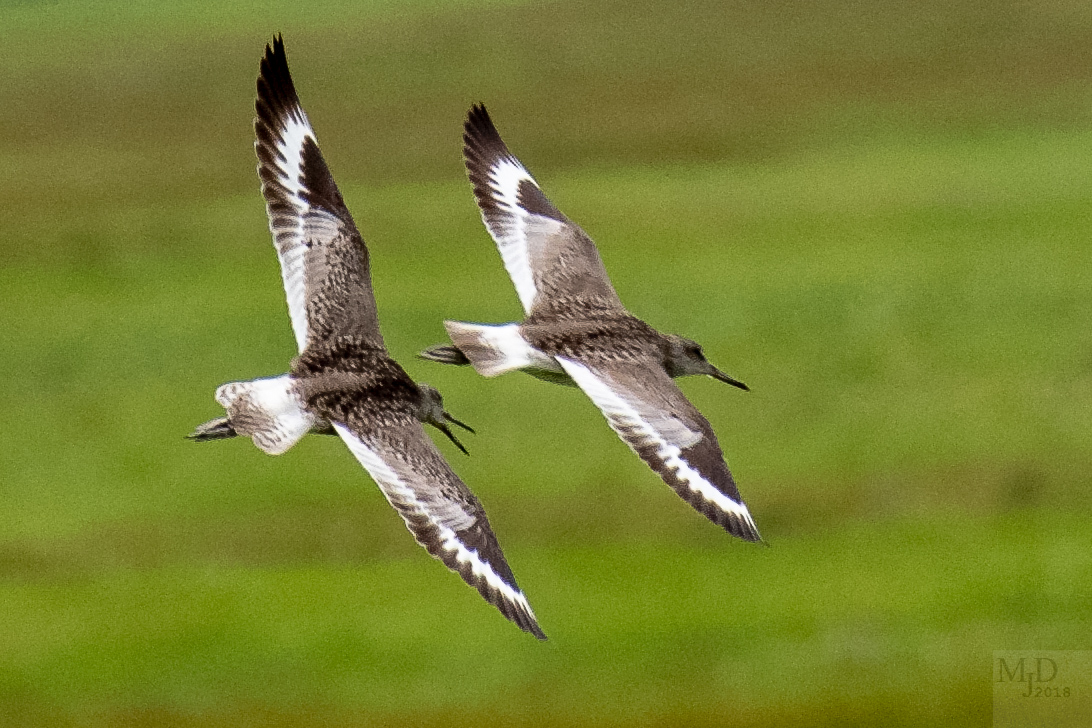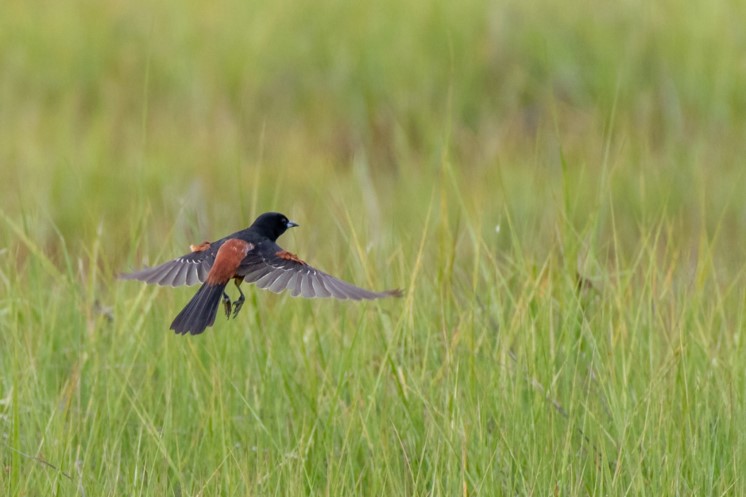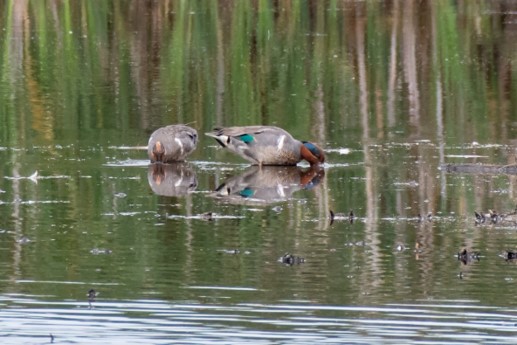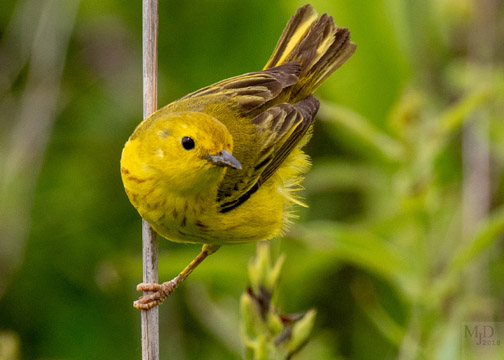Shorebirds continued to be the dominant feature of our outing this week, as Dave Weaver and I led a group of 18 or so birding on Plum Island. We made a quick first stop at parking lot #1 to see the Purple Martin colony, which was bursting with young martins. They were hanging around on the power lines near the gatehouse and flying around the area in the loosest of flocks, more like a disorganized gang. Sue McGrath, who has been studying the colony all season, will have results to share soon, but things are looking pretty good.
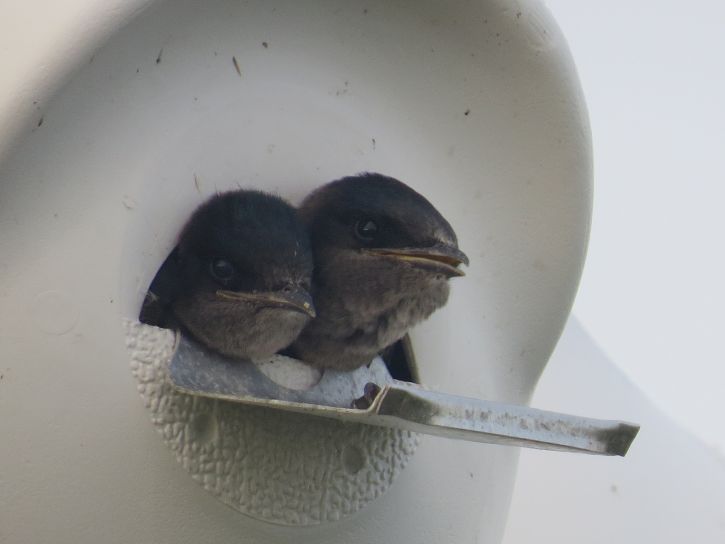
Purple Martin fledglings in late July – Dave Adrien
As we began our drive down the refuge road, the first thing I noticed was that Tree Swallow numbers had declined from the numbers that were there over the previous week. Migration does not run like a machine. Weather systems push migrants into clumps, either because of encouraging conditions or fronts that present obstacles. If there is a particularly good crop of some forage or prey item, a population on the move can pause to build fat, or if there is a dearth, the birds may need to linger until they are sufficiently fueled to keep moving. The bayberries appear to be just ripening, at least in some spots. We certainly expect lots more swallows as August continues. We saw Least Terns all along the waterways, pannes, and pools this week, and Mike D captured one beautifully below.
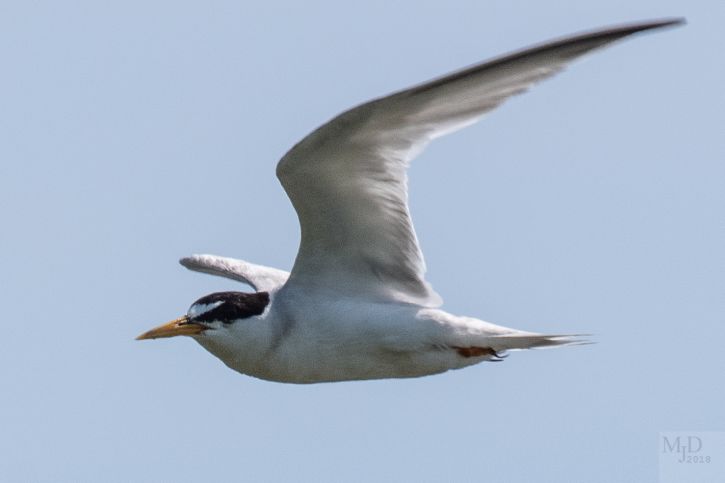
Least Tern – Mike Densmore

Wild Turkey hen with young chicks – Mike Densmore
Our first real stop was at the small pannes south of the Main Salt Panne, where we found a collection of shorebirds and a showy Snowy Egret. Least Sandpipers were close and easy to photograph in the morning light, and Semipalmated Sandpipers and Plovers were scattered on the little islands of salt marsh grass. One Spotted Sandpiper snuck around, while a Killdeer loitered. After enjoying these shorebirds and a few nice waders, a parade of very late Wild Turkey poults came by, led by Mom. They were so much smaller than the other immature turkeys we see about now, that we wondered if their chances are lower by starting so late in the season.

Snowy Egret in the Salt Pannes – Dave Salt

Least Sandpiper – Mike Densmore
Next was North Pool Overlook, a spot that we don’t always check for shorebirds, but that can offer surprises. On Wednesday, it was where our best birding happened. There were dowitchers foraging nearby across the pool, and we quickly noticed a White-rumped Sandpiper among them, one of the species we brushed up on in the lobby before we departed. One of the dowitchers stood out in its definitively more intense coloration and the general impression that it had a heavier fore-body, leading at least some of us, myself foremost, to think it was a Long-billed Dowitcher, among many Short-billed Dowitchers. We saw a strong wash of rufous from chest through belly, and were able to compare this bird with its worn alternate plumage to others in a similar state of plumage around it. The charm or challenge of shorebirding now, is the mix of adults who are in varying stages of molting. Some are in “breeding,” “winter,” and in-between plumage. There is also a changing mix of birds in juvenile plumage, and then all of the above display differences from one regional population to another! Dowitchers are notoriously difficult/impossible to differentiate. Experts disagree about the utility of the image below, but we called the one in back a Long-billed Dowitcher, though others think it is a Short-billed Dowitcher from central North America, the hendersoni subspecies.
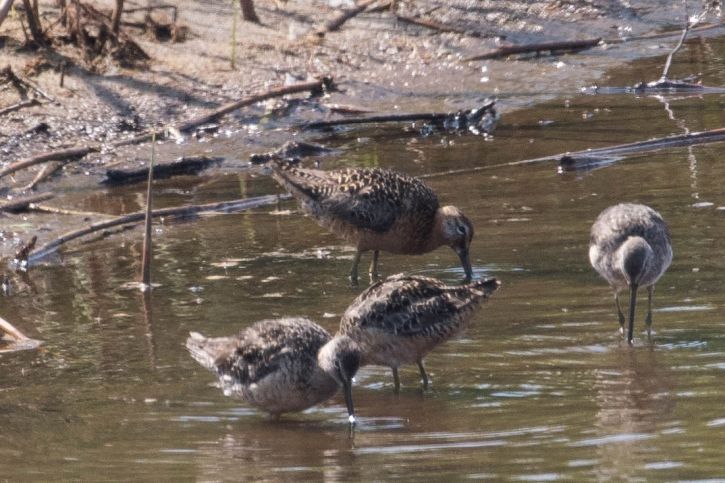
Dowitchers – David Moon
An adult Black-crowned Night-Heron lurked in a cedar among the Phragmites, and more White-rumped Sandpipers appeared on a far spit of mudflat. They seem to be using that island as a place to hide before emerging after dusk to forage, as our evening group discovered several more there.
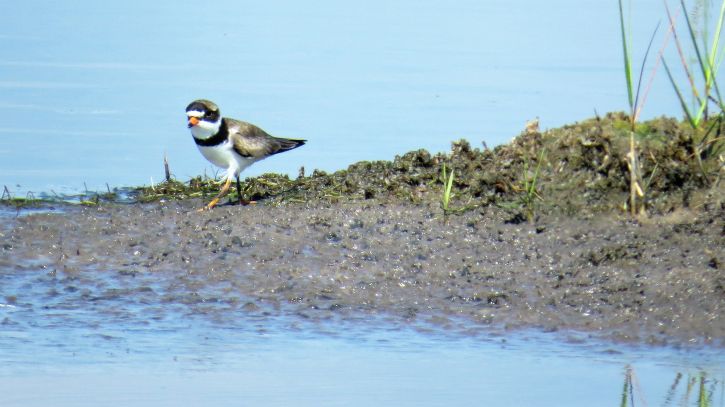
Semipalmated Plover – Dave Salt
Our next spot was the beach platform at parking lot #7, which is now open and is many more feet above the sand than it was before a March storm took away the dune it rested on and the stairs to the beach. From our perch, we found many Sanderlings, a handful of Piping Plovers, and some Ruddy Turnstones far out on Emerson Rocks. The Piping Plovers were foraging on the exposed sand flats, using their technique of shuffling a foot in front of them to push prey to the surface.
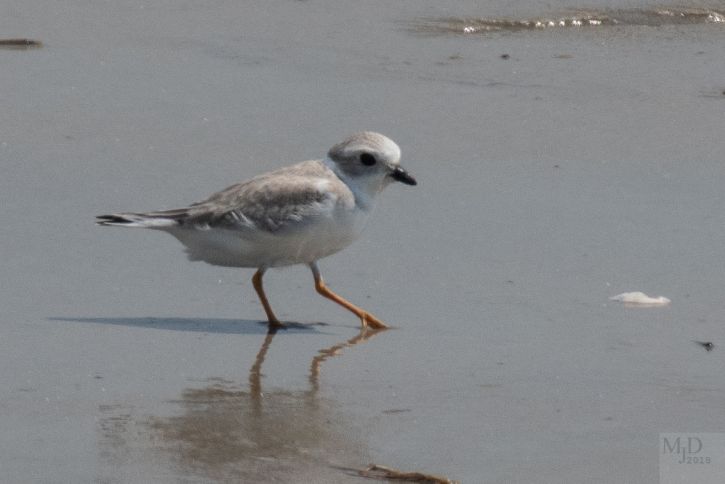
Piping Plover fledgling shuffling for prey – Mike Densmore
Our list:
Canada Goose (~ 30) – Bill Forward Pool.
American Black Duck (2) – small pannes.
Mallard (3) – Bill Forward Pool.
Wild Turkey (~ 13) – 1 hen & ~ 12 poults, crossing road, small pannes.
Double-crested Cormorant (~ 12)
Great Blue Heron (2) – 1, Bill Forward Pool; 1, small pannes.
Great Egret (~ 7)
Snowy Egret (~ 20)
Black-crowned Night-Heron (1) – in cedar on North Pool Overlook island. (Thanks Dave Adrien!) Osprey (2) – 1, Bill Forward Pool; 1, small pannes.
Black-bellied Plover (~ 50) – Bill Forward Pool.
Semipalmated Plover – many, Bill Forward Pool.
Piping Plover (4) – Parking lot # 7 beach.
Killdeer (1) – small pannes.
Spotted Sandpiper (1) – small pannes.
Greater Yellowlegs (~ 8) – 2, North Pool Overlook; ~ 6, Bill Forward Pool.
Lesser Yellowlegs (~ 15) – 6, North Pool Overlook; ~ 9, Bill Forward Pool.
Ruddy Turnstone (4) – Emerson Rocks.
Sanderling (~ 25) – Parking lot # 7 beach.
Semipalmated Sandpiper – many, Bill Forward Pool.
Least Sandpiper (4) – 3, small pannes; 1, Bill Forward Pool.
White-rumped Sandpiper (6) – North Pool Overlook.
Short-billed Dowitcher (~ 43) – 18, North Pool Overlook; ~ 25, Bill Forward Pool.
Long-billed Dowitcher (1) – North Pool Overlook; with SBDOs; photos.
Ring-billed Gull (1)
Herring Gull (1)
Least Tern (~ 12) – various.
Mourning Dove (3)
Peregrine Falcon (1-2) – 1, perched in dead tree North Field (thnks, Dave Adrien!); 1, Bill Forward Pool(same as dead tree bird?).
Eastern Kingbird (~ 10) – various.
Purple Martin (~ 15) – parking lot #1.
Tree Swallow – many.
Black-capped Chickadee (1) – Hellcat.
Gray Catbird (2)
European Starling – many.
Cedar Waxwing (~ 6)
Yellow Warbler (1)
Eastern Towhee (4)
Song Sparrow (3)
American Goldfinch (5)
House Sparrow (1)


